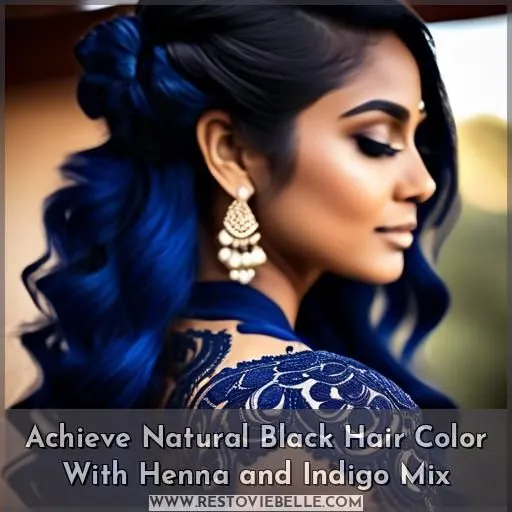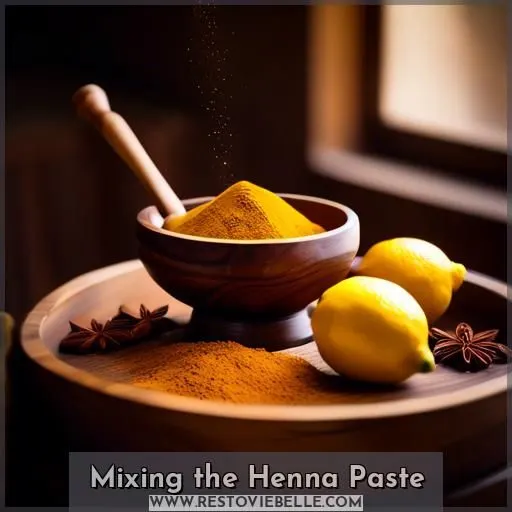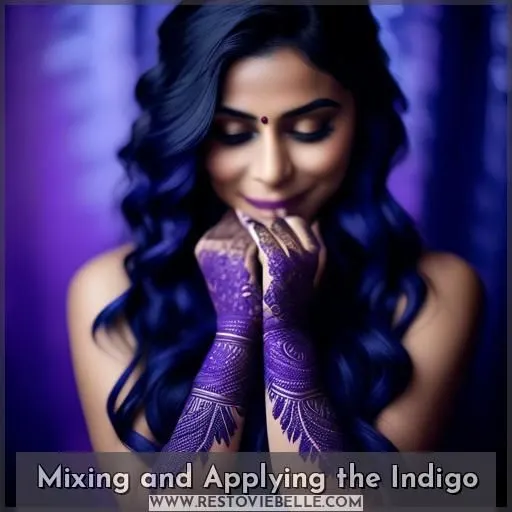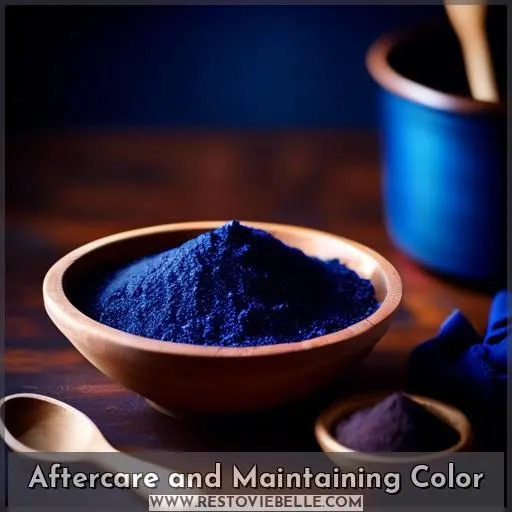This site is supported by our readers. We may earn a commission, at no cost to you, if you purchase through links.

To achieve natural black hair using henna and indigo, follow these steps:
Mix equal parts (50/50 ratio) of henna and indigo powders.
First, prepare a smooth henna paste, apply to clean hair, and leave for 1-4 hours.
Rinse.
Then immediately follow with the indigo paste, adjusting it with salt to enhance color.
Wrap your hair and let the indigo process overnight for maximum adherence.
This potent blend will delicately stain your strands a rich, glossy black.
For best results and color maintenance, consider the intricate steps involved in this ancient art form.
Table Of Contents
- Key Takeaways
- How to Mix Henna and Indigo for Black Hair?
- Preparing Your Hair and Workspace
- Mixing the Henna Paste
- Applying the Henna
- Mixing and Applying the Indigo
- Aftercare and Maintaining Color
- Frequently Asked Questions (FAQs)
- What is the recommended waiting time between applying henna and indigo for black hair?
- How long should the henna paste be allowed to oxidize before applying indigo?
- Can I use cold water to mix indigo powder?
- What is the recommended time to leave indigo paste on the hair before rinsing it out?
- Can I mix henna and indigo together for black hair without any issues?
- Conclusion
Key Takeaways
- Mix equal parts (50/50 ratio) of henna and indigo powders.
- Apply henna paste to clean hair, leave for 1-4 hours, then rinse.
- Immediately follow with indigo paste, adjusting it with salt to enhance color.
- Wrap hair and let indigo process overnight for maximum adherence.
How to Mix Henna and Indigo for Black Hair?
To mix henna and indigo for black hair, first apply a henna paste and let it sit, then mix indigo with water and apply it to achieve a deep black color. This two-step process involves using henna to prime the hair before adding indigo, ensuring a rich, natural black shade.
Preparing Your Hair and Workspace
Ready to achieve that natural black hair color? Start by selecting the right henna and indigo powders, and gather all the necessary tools and materials for a smooth application process.
Choosing the Right Henna and Indigo
Choosing the Right Henna and Indigo for Your Hair Dye Adventure
When it comes to achieving a natural black hair color, using henna and indigo is a popular option. These plant-based dyes have been used for centuries and offer a range of benefits for your hair. Here are some key considerations for selecting the right henna and indigo for your hair dye project:
-
Henna History and Indigo Origin: Henna is derived from the Lawsonia Inermis plant, while indigo is extracted from the Indigofera plant. Both have a long history of use in hair dye and have been known for their healing and disease-fighting properties.
-
Plant-Based Dyes: Henna and indigo are both natural, plant-based dyes. They don’t contain any synthetic chemicals, making them a safer alternative to conventional synthetic chemical hair dyes.
-
Dye Release Time: Henna and indigo dyes release their color over time. Henna typically needs to be left on for 1-4 hours before rinsing, while indigo should be applied within 72 hours of henna application and left on for 15-20 minutes.
-
Henna and Indigo Safety: Pure henna and indigo are generally considered safe for use on hair. However, it’s imperative to perform a patch test on your skin before applying them to your hair to ensure you aren’t allergic to either dye.
-
Black Hair and Natural Hair Dye: Henna and indigo can provide a natural black hair color when used together. Henna alone will result in shades of auburn, brown, and black, while indigo can be mixed with henna to achieve medium brown shades.
-
Hair Health: Henna and indigo can improve hair health by providing nourishment, sealing the hair cuticle, and aiding in the prevention of split ends and hair breakage.
When selecting your henna and indigo, make sure you choose pure, plant-based powders without any added chemicals. This will help you achieve the best results and minimize any potential risks. Happy dyeing!
Gathering Necessary Tools and Materials
To obtain natural black hair coloration with henna and indigo, you’ll require the appropriate tools and materials. Begin by selecting high-grade henna and indigo powders. Seek pure, organic powders devoid of additives, as these will yield superior results. Verify that the powders are free of abrasive chemicals and are compatible with your hair type, whether it’s gray or chemically treated.
Next, prepare your workspace. Ensure the area is well-ventilated to prevent any disagreeable odors from the henna and indigo powders. Wear protective attire, such as an old shirt or apron, to prevent staining. It’s also advisable to cover your work surface with a disposable tablecloth or plastic sheeting for easy cleanup.
In addition to the henna and indigo powders, you’ll need a few other items:
- Lemon: This will assist in activating the henna and releasing the dye.
- Salt: A small quantity of salt can be added to the indigo paste to enhance adherence and color development.
- Cornstarch: Mixing cornstarch with the indigo paste can facilitate application.
- Warm water: You’ll need this to mix the henna and indigo powders.
- Plastic wrap and a processing cap: These will aid in wrapping your hair and maintaining heat for maximum dye absorption.
Mixing the Henna Paste
To create the perfect henna paste, you’ll need to get the proportions just right based on your hair length. Mix the henna powder with lemon juice and water until you achieve a smooth, pudding-like consistency, then let it sit for 1-4 hours to allow the dye to fully release.
Proportions for Different Hair Lengths
To obtain optimal outcomes with henna and indigo hair dye, it’s imperative to contemplate the measurements relative to your hair length. Here are some guidelines:
- For short hair (up to shoulder length): Utilize 50-100 grams of henna powder and 50-100 grams of indigo powder.
- For medium hair (shoulder length to waist length): Utilize 100-200 grams of henna powder and 100-200 grams of indigo powder.
- For long hair (waist length or longer): Utilize 200-300 grams of henna powder and 200-300 grams of indigo powder.
These measurements can be adjusted based on the preferred color intensity and your hair’s natural color. Recall that henna is more permanent and will mask gray hair, while indigo provides a transient black color that persists for approximately 8 weeks. It’s also vital to blend the henna with lemon juice the night before and apply it to moist or dry hair, commencing from the front and progressing towards the back.
Achieving the Right Consistency
To achieve the right consistency for your henna paste, mix henna powder with lemon juice and water until it forms a pudding-like texture.
Allow the paste to oxidize to brown, indicating dye release. This process can take up to 4 hours, depending on the amount of henna used.
Once the paste has reached the desired consistency, it’s time for application. Section your hair and apply the paste starting from the roots, working through each section.
Wrap your hair in plastic wrap and a processing cap for at least 2 hours or overnight.
Rinse out the henna paste and repeat the process with indigo powder for black hair.
Dye Release Time
Dye release time is a critical factor in achieving the sought-after natural black color with henna and indigo hair dye. Here are three key points to keep in mind:
- Henna Dye Release: Henna dye release time varies depending on the type of henna used and the acidity of the mixture. Some hennas release dye almost instantly, while others may require 5-8 hours for maximum dye release. For most hennas, 3 hours is usually enough time to get the most effect from the already released dye.
- Indigo Dye Release: Indigo dye release time is typically shorter than henna, with some sources suggesting 15-20 minutes for black tones and 3-4 hours for brown tones. However, it is vital to apply indigo after henna application within 72 hours to achieve the best results.
- Temperature and Acidity: Temperature and acidity play a significant role in dye release. Henna mixed with nearly any hot liquid (even pure lemon juice) will release the dye immediately, while more acidic mixes are slower to release and slower to demise. Plain water mixes release dye more quickly than lemon juice mixes, and strong tea times are 1/2 of the lemon juice times.
To guarantee the best results, it’s recommended to test different henna powders and adjust the dye release time accordingly. Always follow the manufacturer’s instructions and consider factors such as temperature, acidity, and the type of henna used to achieve the desired natural black color.
Applying the Henna
When applying the henna paste, be sure to section your hair for even coverage. Use warm heat and allow sufficient processing time to ensure maximum dye uptake before rinsing and preparing for the indigo application.
Sectioning and Application Technique
Before applying the henna paste, make sure your hair is clean and devoid of any product residue. Divide your hair into manageable sections using clips or hair ties.
Use a wide-tooth comb to remove any knots. Apply the henna paste to the roots, working your way down the hair shaft. Apply a thin layer around the hairline to prevent staining.
Wrap your hair in plastic wrap and a processing cap to keep the henna warm and enhance dye absorption. Allow the henna to process for at least 2 hours or overnight.
Timing and Heat for Optimal Dye Uptake
To achieve the best dye absorption with your henna and indigo mixture, it’s essential to understand the importance of heat and timing. Apply the henna paste to your hair, starting from the roots and working through the sections.
For auburn hues, let the henna release dye for 1-4 hours.
For medium brown, mix 40% indigo and 60% henna.
For black tones, mix 50% indigo and 50% henna.
Use warm water, apple cider vinegar, or green tea to mix the paste. Avoid thick liquids that lessen the color. Mix to a pancake batter consistency.
Cover your hair tightly in plastic wrap to reduce odor and improve color development. Process for at least 2 hours or overnight.
Rinsing and Preparing for Indigo
Washing your hair after applying henna is critical to get it ready for the next step: indigo. Here’s a simple 3-step guide to guarantee a successful transformation:
- Rinse Completely: After the henna has been left on your hair for the recommended time, rinse it out using lukewarm water. Make sure to remove all the paste, as any residue can impact the color of the indigo.
- Dry Your Hair: Let your hair dry completely before applying the indigo paste. This step is essential to make sure the indigo sticks properly to your hair.
- Prepare the Indigo Paste: Mix indigo powder with salt, cornstarch, and water to form a paste that looks like pudding. Make sure the consistency is similar to that of the henna paste.
Mixing and Applying the Indigo
To create the perfect natural black hair color, you’ll need to adjust the indigo for your desired tone. Apply the indigo paste directly over your henna-treated hair, then wrap it up and let it process for the most effective results.
Adjusting Indigo for Desired Black Tones
To achieve the desired black tones, you can adjust the indigo by adding salt to open the hair shafts. This process, known as oxidation, allows the indigo to gloss over any red hues, reducing redness and achieving the desired brown and auburn shades.
For a more subtle black, mix cassia with your henna and indigo. This dilution process prevents darkening of previously dyed hair and adds volume.
Application Over Henna-Treated Hair
Applying indigo over henna-treated hair is a vital step in achieving a natural black hair color. Here’s how to do it:
- Mix Indigo with Salt: Add salt to your indigo paste to improve its adhesion to your hair.
- Apply Indigo to Root Touch-Ups: Focus on your roots for the best coverage and color enhancement.
- Adjust Indigo Intensity: Use less indigo for lighter shades or more for darker tones.
- Dilute Indigo with Cassia: Mix in cassia to prevent the indigo from darkening previously dyed hair.
Wrap and Time for Indigo Processing
Once you’ve applied the indigo paste, it’s time to wrap things up—literally. Wrapping your hair in plastic wrap isn’t just a quirky beauty hack; it’s a game-changer for color development enhancement. Let the indigo work its magic overnight to guarantee maximum adherence and a bold, black hue that speaks volumes. Remember, patience is a virtue, especially in the pursuit of perfect hair.
| Step | Purpose | Duration |
|---|---|---|
| Apply | Indigo adherence to hair | Immediate |
| Wrap | Plastic wrap effectiveness | Overnight |
| Wait | Color development enhancement | 8-10 hours |
| Unwrap | Reveal the transformation | Morning |
| Rinse | Final step to natural black hair | 15-20 min |
Aftercare and Maintaining Color
After rinsing out the indigo, you’ll want to wait a few days before washing your hair again to let the color settle. Reapply the henna and indigo every 4-6 weeks to maintain your desired black shade and keep your hair healthy and nourished.
When to Wash Hair Post-Application
After applying the henna and indigo mix, it’s essential to follow the appropriate rinse timing to preserve color intensity and hair condition. Allow at least 24 hours to elapse before washing your hair, giving the dye ample time to penetrate and set.
During this period, refrain from using heavy liquids that could weaken the color. Once you rinse your hair, integrate hair care products into your regimen to enhance moisture retention and prevent fading.
Regularly accessing hair care tutorials and articles can provide valuable advice for maintaining your transformed appearance.
Frequency of Reapplication for Lasting Color
To keep your black hair vibrant, you’ll need to play the long game with henna and indigo. Here’s the lowdown:
- Frequency: Touch up roots every 4-6 weeks to maintain a uniform shade.
- Reapplication: Full head applications can be spaced further apart, think every 3-4 months, to prevent over-darkening.
- Balance: Alternate between root-only and full applications to keep that rich, brown-to-black spectrum just right.
Frequently Asked Questions (FAQs)
What is the recommended waiting time between applying henna and indigo for black hair?
For rich, black tones, you’ll want to apply the indigo within 72 hours after the henna. This one-two punch lets the dyes work their magic, giving you vibrant, glossy strands that’ll turn heads.
How long should the henna paste be allowed to oxidize before applying indigo?
Up to 90% of henna’s color comes during oxidation – you’ll want to let your henna paste rest for 6-12 hours before applying indigo. Trust the process; good things come to those who weight!
Can I use cold water to mix indigo powder?
No, you can’t use cold water for indigo. It needs warm water to fully release the dye particles. Warm it up, and you’ll reveal that deep, bewitching black tone you crave.
What is the recommended time to leave indigo paste on the hair before rinsing it out?
Craving that vibrant, jet-black hue? Leave the indigo paste on for at least 6-8 hours, or overnight if you dare. Don’t rush perfection – the longer you keep it on, the richer the color payoff.
Can I mix henna and indigo together for black hair without any issues?
Yes, you can absolutely mix henna and indigo for a rich, natural black hair color. Follow the right ratios and techniques, and you’ll make possible the power of vibrant, chemical-free locks.
Conclusion
Envision your locks transformed into lustrous ebony strands with the ancient artistry of henna and indigo blend. Diligently adhering to this precise process rewards you with natural, glossy black hair. Regular maintenance and periodic reapplication guarantee that your tresses remain vibrantly hued, a stunning affirmation of your mastery in mixing henna and indigo for black hair.










